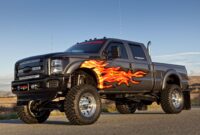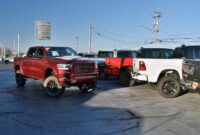Loading Log Trucks: The Art and Science of Maximizing Efficiency and Safety cars.truckstrend.com
In the vast and dynamic world of the timber industry, the journey of a tree from forest to mill is a complex ballet of machinery, skill, and precision. Among the most critical steps in this process is the loading of log trucks. Far from being a mere act of piling logs onto a vehicle, it is a highly specialized discipline demanding a keen understanding of physics, safety regulations, and operational efficiency. Proper log truck loading is not just about moving wood; it’s about maximizing payload, ensuring driver and public safety, minimizing environmental impact, and ultimately, safeguarding the profitability of the entire forestry operation. This comprehensive guide will delve into the intricacies of this vital task, transforming it from a simple chore into an optimized art form.
I. The Foundation: Understanding Log Truck Components and Regulations
Loading Log Trucks: The Art and Science of Maximizing Efficiency and Safety
Before a single log is lifted, a thorough understanding of the vehicle receiving the load is paramount. Log trucks are purpose-built machines, typically consisting of a powerful tractor unit and a specialized trailer equipped with:
- Bunks: Heavy-duty cross-members that support the logs.
- Stakes/Standards: Vertical posts attached to the bunks, designed to contain the logs laterally.
- Headache Rack: A protective barrier behind the truck cab to prevent logs from shifting forward into the driver’s compartment during sudden stops.
- On-board Scales: Increasingly common, these integrated systems provide real-time weight measurements for each axle and the total gross vehicle weight (GVW).
Beyond the hardware, stringent regulations govern the weight and dimensions of loaded log trucks. These laws vary significantly by jurisdiction (state, province, country) but generally cover:
![]()
- Gross Vehicle Weight (GVW): The maximum permissible total weight of the truck, trailer, and its cargo.
- Axle Weights: Limits on the weight distributed over individual axles or axle groups to prevent road damage and ensure vehicle stability.
- Length, Height, and Width Restrictions: Maximum allowable dimensions to ensure safe passage on roads, under bridges, and through tunnels.
![]()
Adherence to these regulations is not optional; violations can result in hefty fines, delayed shipments, and even the impounding of the vehicle. A skilled loader operator constantly considers these limits, ensuring every load is both full and legal.
II. Essential Equipment for Loading Log Trucks
The efficiency and safety of log loading are heavily reliant on the right tools for the job.
A. Primary Loading Machinery
- Hydraulic Log Loaders (Excavator-based): These are perhaps the most common and versatile machines. They are essentially excavators modified with a specialized log grapple attachment. Their tracked undercarriage provides stability on uneven terrain, and their powerful hydraulics offer precise control for handling individual logs or small bundles. They excel in sorting, decking, and direct loading from the stump or roadside piles.
- Purpose-Built Knuckleboom Loaders: Often mounted on a self-propelled carrier, a truck, or a dedicated trailer, these loaders feature a "knuckle" or articulated boom that allows for excellent reach and maneuverability. They are highly efficient for roadside loading where logs are already sorted and piled.
- Wheel Loaders with Grapples: While less common for direct loading of individual logs onto trucks due to their less precise control, wheel loaders are invaluable for moving large volumes of logs, creating decks, and feeding processing equipment at mill yards. Some specialized log grapples can make them suitable for loading certain types of pre-bunched timber.

B. Supporting Tools & Safety Gear
- Grapples: The "hands" of the loader, designed to securely grip logs. Various sizes and types exist for different log dimensions and applications.
- Scales: On-board truck scales, portable wheel weighers, or dedicated static scales at landings are crucial for ensuring legal weight.
- Tie-Down Chains/Straps and Binders: Essential for securing the load to the truck bunks, preventing movement during transit.
- Personal Protective Equipment (PPE): Hard hats, high-visibility vests, safety-toe boots, gloves, and eye/ear protection are mandatory for all personnel working in the loading zone.
III. The Art of the Load: Techniques and Best Practices
Loading a log truck is a skilled operation that balances speed with precision, volume with stability, and efficiency with safety.
A. Pre-Loading Preparation
- Truck Positioning: The truck must be positioned on stable, level ground, if possible, with clear access for the loader. The driver should ensure air brakes are set and the vehicle is secure.
- Truck Inspection: A quick check of the truck’s bunks, stakes, tires, and securement points ensures it’s ready to receive a load.
- Assessing the Log Pile: The loader operator evaluates the available logs, considering their length, diameter, species, and straightness to plan the load strategically. Sorting logs by size or destination may occur at this stage.
B. Loading Sequence and Placement
The goal is to create a dense, stable, and legally compliant load that won’t shift during transit.
- Building the Foundation: Begin by placing the largest, straightest logs on the bottom bunks. These logs form the "foundation" of the load, providing stability and a flat surface for subsequent layers. Ensure they are evenly distributed across the bunks and extend adequately to the front and rear.
- Layering for Stability: Subsequent layers should interlock with the logs below, preventing shifting. Avoid creating "rockers" – logs that sit unstable and can cause the load to collapse. Logs should be placed alternately (butt-to-top, top-to-butt) to maintain balance and optimize volume.
- Creating the "Crown": Loads are often built higher in the middle, forming a slight "crown" or "dome." This helps to compress the load when secured and allows for greater volume while keeping the outer logs below the stake height for initial securement.
- Filling Voids: Skillfully use smaller logs or "fillers" to eliminate significant gaps within the load, increasing density and stability.
- Maximizing Volume, Ensuring Containment: The loaded logs must remain within the confines of the bunks and stakes. No logs should protrude dangerously beyond the sides. The overall height must comply with regulations.
C. Weight Management and Distribution
This is where the science truly comes into play.
- Axle Weight Distribution: Uneven weight distribution can lead to fines, tire blowouts, and dangerous handling characteristics. Operators use their experience, combined with on-board scales, to balance the load front-to-back and side-to-side. Heavier logs are often placed over the drive axles, while lighter logs might be used towards the ends of the trailer.
- Real-time Adjustments: Modern on-board scales allow operators to monitor weights as they load, enabling immediate adjustments by shifting logs or adding/removing material until the legal limits are met.
D. Securing the Load
Once loaded, the logs must be securely fastened.
- Chain/Strap Placement: Chains or high-strength synthetic straps are draped over the load, typically at the front, middle, and rear sections, depending on load length and regulations.
- Tensioning: Binders (ratchets or lever-type) are used to apply immense tension, compressing the load and preventing movement. Chains must be checked and re-tensioned after the first few miles of travel (the "settling" period) and periodically throughout the journey.
- Regulatory Compliance: The number and strength of tie-downs are often stipulated by law (e.g., minimum of two per bunk, or one every X feet).
IV. Safety First: Mitigating Risks in Log Loading
Log loading is inherently dangerous, involving heavy machinery, unstable loads, and dynamic environments. Safety must be the paramount concern.
A. Hazard Identification
- Falling Logs: The most significant risk, especially during loading, unbinding, or transport.
- Equipment Rollover: On uneven or soft terrain, particularly with tracked loaders on slopes.
- Pinch Points: Between the loader’s moving parts and logs, or between logs themselves.
- Struck-by Hazards: From swinging grapples, moving logs, or other equipment.
- Unstable Ground: Leading to equipment sinking or tipping.
B. Safe Operating Procedures
- Clear Communication: A designated spotter or clear hand signals and radio communication between the loader operator and truck driver are essential.
- Maintain Safe Distances: No one should be in the swing radius of the loader or under a suspended load.
- Pre-Operation Checks: Daily inspection of the loader (hydraulics, tracks/tires, grapples, lights, safety systems) is critical.
- Proper Training and Certification: All loader operators must be fully trained, certified, and experienced.
- Site Management: Keeping the loading area clear of debris, establishing clear traffic patterns, and having good lighting.
C. Emergency Protocols
Having a well-defined emergency plan, including first aid kits, emergency contact information, and spill containment procedures, is crucial for any logging operation.
V. Challenges and Solutions in Log Loading
The logging environment presents unique challenges that require adaptability and skill.
- Uneven Terrain/Weather: Loading on slopes or in muddy/icy conditions significantly increases risk.
- Solutions: Utilizing track-mounted loaders for stability, carefully selecting loading sites, using matting or gravel for stability, and reducing speed in adverse conditions.
- Varied Log Sizes/Species: Mixing small and large logs, or different species with varying densities, complicates weight distribution and stability.
- Solutions: Pre-sorting logs, experienced operators skilled in mixed loading techniques, and careful placement to balance the load.
- Over/Under Loading: Overloading is illegal and dangerous; underloading is inefficient and unprofitable.
- Solutions: Relying on accurate on-board scales, calibrating scales regularly, and continuous training for operators on weight estimation.
- Equipment Malfunctions: Downtime due to breakdowns is costly.
- Solutions: Regular preventative maintenance, readily available spare parts, and skilled mechanics.
VI. Optimizing Efficiency and Profitability
Efficient log loading is a cornerstone of a profitable timber operation.
- Minimizing Idle Time: Keeping the loader active and trucks moving. This often involves effective communication between the forest crew, loader operator, and truck drivers.
- Efficient Sorting and Staging: Pre-sorting logs by length, diameter, or destination can significantly reduce loading time.
- Skilled Operators: An experienced operator can load a truck faster, safer, and more accurately, maximizing payload while staying legal.
- Proper Equipment Selection and Maintenance: Using the right loader for the job and ensuring it’s well-maintained reduces breakdowns and increases productivity.
- Accurate Scaling and Load Management: Precisely managing weight ensures full legal loads every time, optimizing transport costs per unit of wood.
Conclusion
Loading log trucks is a deceptively complex operation that forms a critical nexus in the timber supply chain. It is a harmonious blend of heavy machinery operation, adherence to strict safety protocols, and a nuanced understanding of physics and regulations. From the initial assessment of the log pile to the final securement of the load, every step demands precision, experience, and an unwavering commitment to safety. By mastering the art and science of log truck loading, forestry operations can significantly enhance their efficiency, ensure the well-being of their workforce, and contribute to the sustainable and profitable movement of timber from forest to market.
Price Table: Costs Associated with Loading Log Trucks (Estimates)
It’s challenging to provide a fixed "price" for loading log trucks as it’s typically a service integrated into a larger logging operation, or dependent on equipment rental/ownership, labor rates, and volume. Below is a breakdown of estimated costs or factors influencing cost per hour or per truckload. These figures are highly variable based on region, equipment type, operator experience, and market conditions.
| Cost Component | Unit of Measurement | Estimated Range (USD) | Notes
![]()



